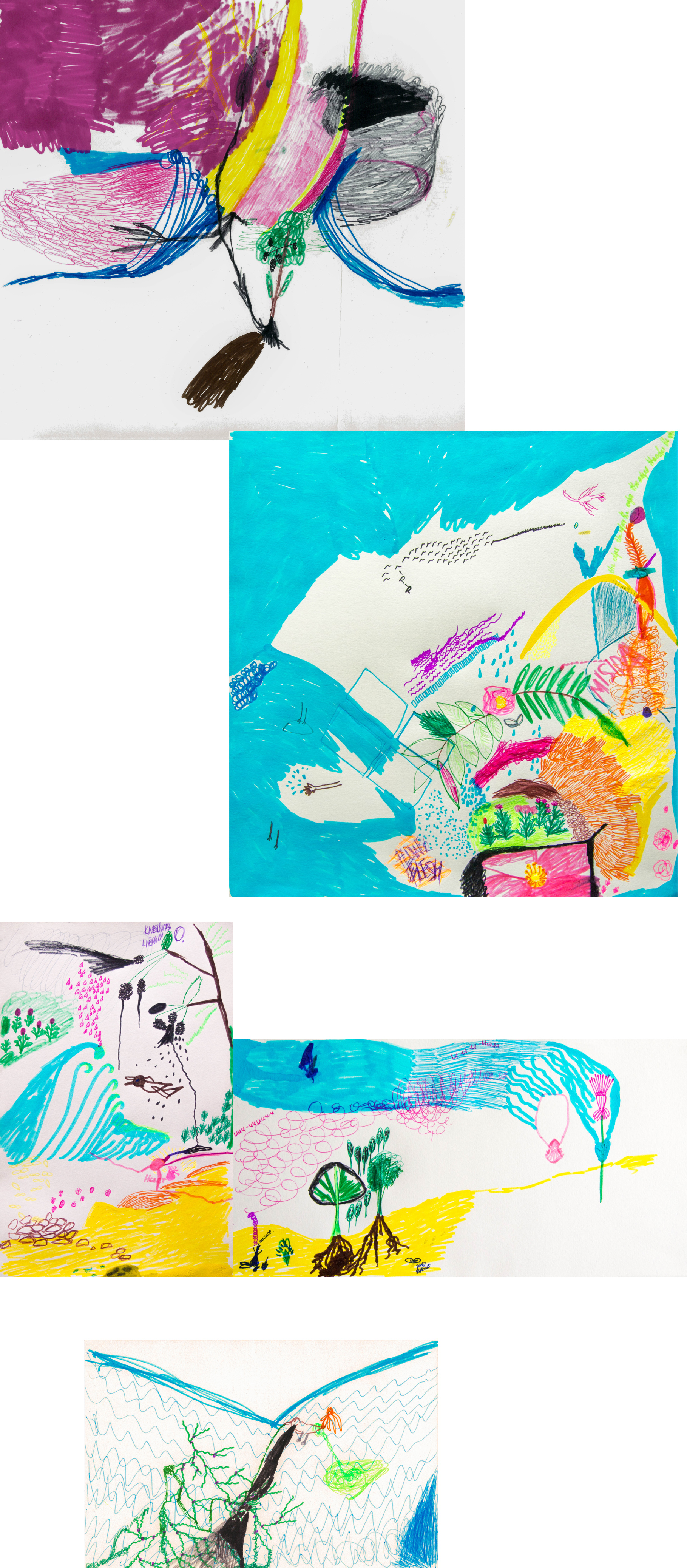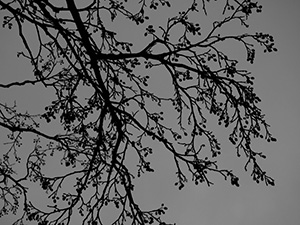Issue № 8
May 2016
Sea Lover  Events
Events  Storm, Heart
Storm, Heart

«Sea Lover» by artist Jaenne Dolgova.


December 23: I am back in the west to find the heart.
The sky is low and black. It is raining, you need to hide in the ruins to wait it out. From the arch, you can see the forest. Under the sagging round clouds, the trunks of aspens glow green and gray.
The entire island lowland core is flooded with water. The sky is reflected in it, black as well. Small ripples and quiet drops carefully touch the motionless, washed trees.
Tussocks with moss, dark purple aspen leaves, and overwintering lying ferns rise from the water. I want to think about newts that sleep in the tussocks. They lie in vulnerable hooks: orange bellies, tiny fingers.
The rain is over. A storm can be heard and seen from inside the aspen grove: a vast roar and a steely yellow light. I cannot dare to go out and meet it.

The waves left a sign: far, far from the shore lies a strip of soft spongy lakeshore bulrush stems. Beyond the beach, beyond the alders, beyond the dunes. The waves boast: we reached here last night. We have passed half of the island. Now that was a storm!
What else have the waves done?
Brought fine clean sand to the swamps behind the dunes. In some places, it lies like delicate tongues, while in others, it almost buried young trees.
Smashed half of the dune. It was difficult because the dune was anchored by wild roses' rhizomes. The waves also took the wild roses.
They unsoiled (even more than before) the roots of the frontmost trees. They fell an alder tree, and another, and another, and a willow tree, and the next one was dragged away entirely.
Many tufts of roots were pulled out of the sand and thrown onto low branches. If the crushed lakeshore bulrush strip shows how far the waves have gone, these roots reveal how high they rose. And, it seems the island was no longer here at night: only water and trees. But now, in the morning, you can walk along a narrow sand line between the sea outside and inside.
There are puddles left on this borderline. Like a kid, I sit and stare into their water, looking for something.


Where the beach is no longer flooded, the sand has become very solid and easily walkable. Walking is too difficult because of the fierce wind from the other side. You can't turn your face; it pressures the whole body and, most of all, the ears. The head will hurt long after. The eyes will be filled with gray smoke.
((You can hide behind an alder tree, and there, just five steps away, will be no wind at all, although the alder grove is not at all dense, especially now, in winter, and stands higher than the beach)
Large lilac-colored shapes on the wet, flat sand, the one which turned gray under the clouds and waves, although it is usually yellow or pink. The shapes have involved outlines with outgrowths and cuts, holes, stripes, and circles. From some of them, bright yellow root threads come out in a uniform pattern.

Here, in the heart, a stunning shiver. It should be explained by the wind and waves; I want to think: they did it, it's because of them, it's because of the waves and the wind.
You are not even trying to resist this mind inertia. But the fallen alder tree looks openly and defiantly: did it really happen to me from the waves?
Red tufts of roots, hanging on dead branches, buzz: what storm are you talking about?
Before this winter, in the summer, caterpillars sprawled inside the island. There were myriads of them; they ate whole trees, shared cocoons on them, gathered in cocoons in tens of dozens, wriggled together under a translucent fabric.
What summoned these caterpillars? How did they occur? Who was their wind if their cocoons became someone else's waves?
Because of them, the middle of the island was unapproachable to me for several weeks.

Heart — no need to think about beating, working, viscosity, or wholeness.
Otherwise: it is calm, like a cloudy night sky. There are sparkling bright eyes in it, looking in all directions and at each other with amazement and vim. They have just opened: with every wind movement, they are opening all anew; they have just opened: amazement is always fresh and untiring.
I found mysids in a puddle. They stood in an invisible, glistening flock in the icy water. Through their transparent formation, one could see the leaves at the bottom, a dead plump white beetle larva, and a dead pink soft worm. From the mysids themselves, one could see black eyes, a scattering of greedy black balls; if the flock was frightened, then its motion became visible — shadows and flashes.
I took a dozen with me. So I learned that, after eating, the mysids like to arch their bodies. Their legs-threads are divided in two, like branches; they swim with one branch and walk with the other.
They are amused by light, whirling, and cold; they carefully look through the water and glass. Outside the heart, they cease to be a flock and turn into a confused scattering.

Forced, pushed to ask.
Today and tomorrow, and in the spring, is it the same heart? — Sometimes.
Are there other similar, independent or related hearts? — No.

In spring, first, the snow disappears on the beach, then the ice melts on the waves, and only after that, very slowly, does the low middle of the island thaw.
The sand on the sunny, open beach differs from what was left by winter storms. It is no longer solid and even — it is bright and greedy for fun. Tiny plateaus and floodplains, patterns and flashes, inflorescences and buds, many faces and bodies evolve in the sand. During these slipping days, the beach knows all the world's shapes and hurries to try them out; hisses, achingly longing. Soon it will forget everything: the waves will come.
Along with the sand, birds arise. Those inside the island and those outside. The former rest in the aspens and do not appear even in the coastal alders. Others come for the water; they do not need land.
Also, there is a bird on the island all year round; it is large but invisible, gently flies from tree to tree, says a thoughtful, slightly surprised, and sad "kruu-kruu-kruu". No matter how cheerful the hubbub around is, this "kruu-kruu" happens like a black blast covering the sunny sky with silent fluff.
Seabirds are all different species, but they gather in one place, in one complex flock. The mysids participate in the heart with their eyes, the seabirds with the ramose cloud of their voices.
In this cloud, not a single voice sings apart but only as a response to the songs that are fading or arising. The sudden and effortless response, slipping off the ice floe into heavy water.

At first, I thought it was a matter of a condensation, of being caught and driven to the edge. If you climb the mound that covers the ruins, you can reach the rounded gray walls. (Although it says nothing at all that these are walls. Their remains are just like rocks; old, rain-washed rocks.)
So, along the beautiful smooth edge of the rocks, various miniature stone-dwelling things grow. Three or four types of mosses, but not flat and dry, intended for such a habitat, but moist, branched, exquisite forest mosses (not a forest there). Lichens of different hues, stonecrop, and other small plants. (I wish there were violets with glossy heart-shaped leaves.) On a narrow strip in front of a sheer emptiness, all of them gathered their own exceptional layer of color and mutual pleasure, in no way similar to the surrounding overgrowth.
Same for the island, I thought. The most essential thing here, in the heart, is the narrow strip between the sea and the swampy lowland inside, water against water, between waters is nature, awakened from restrain. Then I thought: maybe this is the only way to waken nature, to finally look into its eyes, to take its hand? Embracing more and more? Under our human pressure, will nature finally see itself and us?
No, those were entirely wrong thoughts.

G: What makes a specific being a plant?

Anyway, in the story of the heart, there is nothing more important than alder trees.
They grow around the island. Sometimes trees stand far from the water, sometimes right in the waves; every day differs. Alders' trunks don't just rise from the sand. The trees stand on their roots, which are a strong red net, which are naked, which bask in the sun or catch funny prey from the tide.
Then roots merge in the trunk. It smells of smoke and wet soil, emits thin, sharp sparks on one's lips. There is a warm, faithful, and waiting shiver inside it.
Alder branches like a knot of lightning bolts. They want to touch every particle of air and heat as soon as possible, but their desire flows precisely and patiently.
Restrain and condensation: this can be said only about the aspen trees inside the island. Those are afraid of the waves; they curl up inside themselves.
Alders are not afraid of anything: they are not even there.

Lightly and almost accidentally, the heart accepts the human inside. Takes the whole, with eyes and skin, thoughts and speech, coldness and weakness.
(How stupid to think that you need to give up anything or change something)
Becomes one of the fires in the heart, chasing other fires, luring other voices, all at once pierced by cold water and a flash at the edge of the wave.
For the blink can be together with a dark, weightless, sparkling, rapidly burning, melting heart. But always, again and again.

What makes a specific being a plant?
It happened to exist near the wall, evading it without touching or seeing.
They ask: how does the tree know there is a wall here? Or knows something else? This question would apply to those who live contained in the body. It doesn't fit the tree.
The tree moves away from the wall because it is a wall. The tree moves towards the light because it is light and leans towards the wind because it is the wind. The tree is a shadow of a wall, a shadow of light, a shadow of wind or water. Or the tree means the fire of the wall, the fire of light, the fire of heat and fallen leaves.
There is no alder tree: its roots and branches, its trunk, its storm and waves, sunny sand, and the skies of birds. There is nothing more meaningful and existing than this alder tree: inside it.
Inside it, a sight awakens, fresh and demanding; it meets with others of the same kind. They glance at each other and play warmly and unobtrusively.
Being unfolded for a moment in the heart, we see us and the coming waves.

